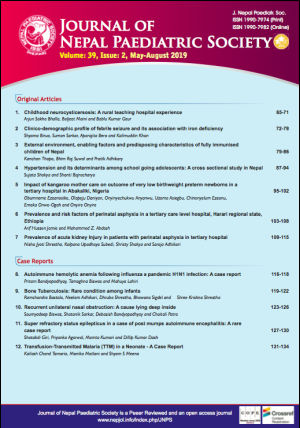Clinico-Demographic Profile of Febrile Seizure and Its Association With Iron Deficiency
DOI:
https://doi.org/10.3126/jnps.v39i2.26964Keywords:
Ferritin, Haemoglobin, MCH, MCHC, MCVAbstract
Introduction: Febrile seizure (FS) is recognised as the most frequent type of seizure in children (age six months to five years). This observational study was conducted in our hospital to assess any possible association of febrile convulsion with iron deficiency anaemia (IDA) and to see the incidence of iron deficiency in six months to five years old children.
Methods: Eighty eight Simple febrile seizure patients of age six months to five years fulfilled the inclusion criteria and were enrolled between April 2018–March 2019. A pre-designed proforma including detailed history, physical examinations, systemic examinations and relevant investigations were filled-up.
Results: Eighty eight subjects with FS were studied. Occurrence of IDA was 67.04% among them. Age was significantly associated with haemoglobin (Hb%) (p-value = 0.000), severity of anaemia (p-value = 0.000), mean corpuscular volume (MCV) (p-value = 0.000), mean corpuscular haemoglobin (MCH) (p-value = 0.000), mean corpuscular haemoglobin concentration (MCHC) (p-value = 0.000) and serum ferritin (p-value = 0.000). However, no significant association between Hb% and gender was found (p-value = 0.890).
Conclusions: Considering the clinico-demographic context of the present study and extent of anxiety and worries of parents of FS children, it is imperative to initiate FS prevention and control programme. Nearly two-third of study subjects had significant low serum ferritin indicating association of simple febrile seizure with IDA. However, prevalence of IDA as a risk factor for FS needs to be studied on adequate and representative sample so that iron supplementation could be started as an inbuilt strategy of simple febrile seizure management.
Downloads
Downloads
Published
How to Cite
Issue
Section
License
Authors who publish with this journal agree to the following terms:
Authors retain copyright and grant the journal right of first publication with the work simultaneously licensed under a Creative Commons Attribution License that allows others to share the work with an acknowledgement of the work's authorship and initial publication in this journal.
Authors are able to enter into separate, additional contractual arrangements for the non-exclusive distribution of the journal's published version of the work (e.g., post it to an institutional repository or publish it in a book), with an acknowledgement of its initial publication in this journal.
Authors are permitted and encouraged to post their work online (e.g., in institutional repositories or on their website) prior to and during the submission process, as it can lead to productive exchanges, as well as earlier and greater citation of published work (See The Effect of Open Access).



